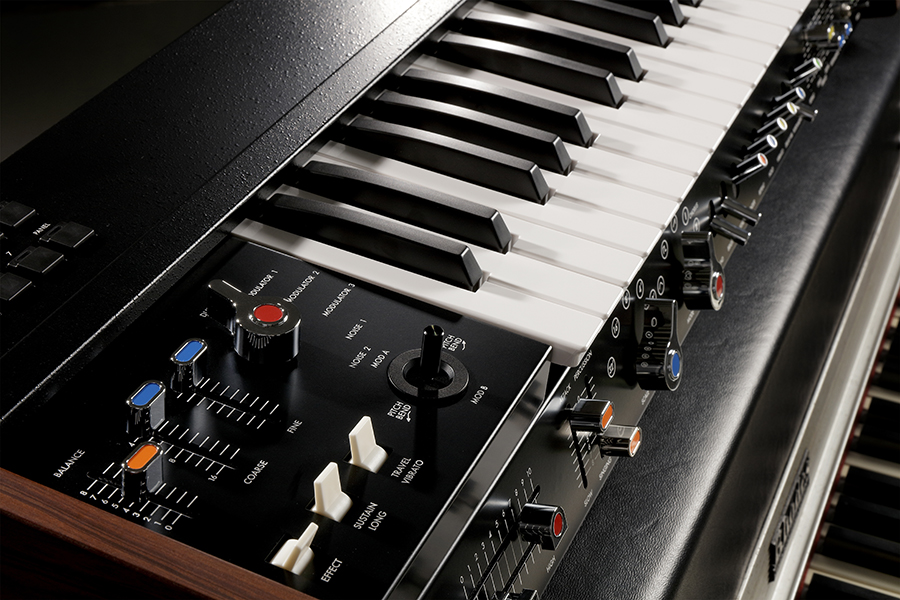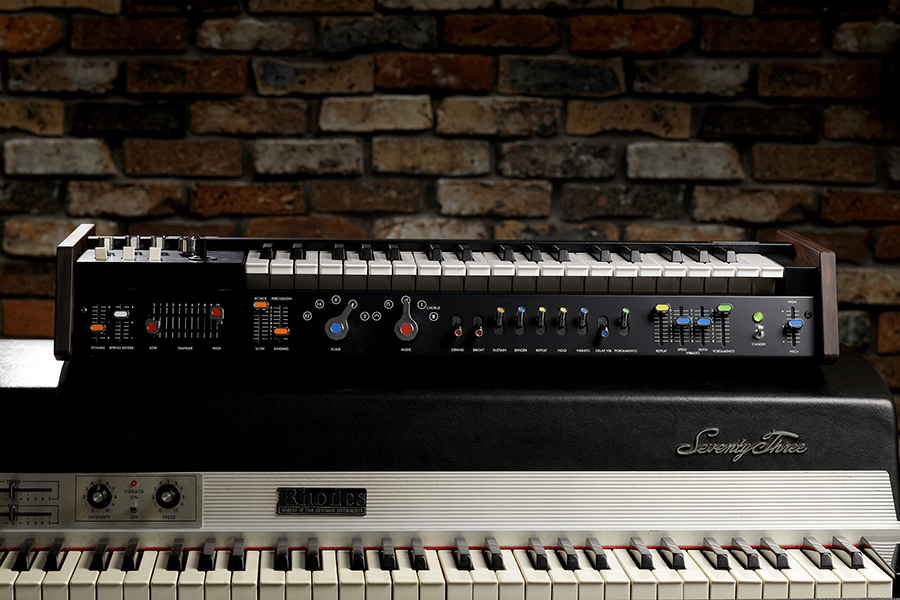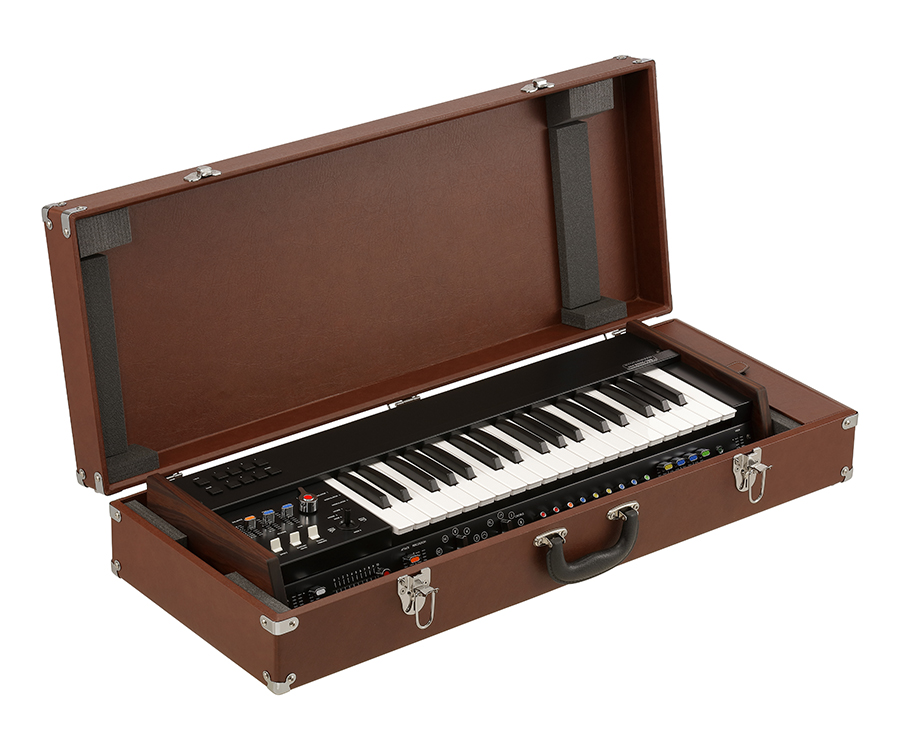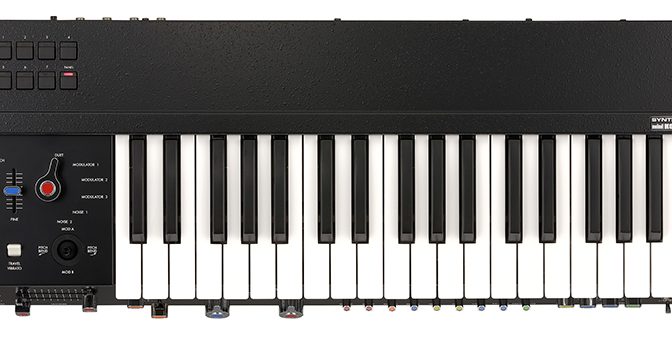Pianos – Keyboard and Synths – Music Instrument News
The miniKORG 700 was KORG’s first mass-produced monophonic synthesizer released in 1973 at a time when the form of synthesizers as musical instruments had not been fully established. After a lot of experimentation, the miniKORG 700 arrived bringing the world of synthesizers to a wide group of users by offering simple operations that could producing extreme changes in sound, and was championed by a strong base of admiring musicians.

Key Features
- A faithful and updated revival of the miniKORG 700S
- Authentic analog designed supervised by Fumio Mieda, who designed the original
- Retains the unique KORG Traveller filter slider controls
- Supplied with two Traveller knob types
- Two oscillators and ring modulator just like the 700S model
- Now has added memory program button (14 memories)
- Spring reverb effect added
- Joystick for pitch bend and modulation.
- Aftertouch for added expressiveness,
- Arpeggiator
- USB port, MIDI IN connector and a CV/GATE IN jack.
- Includes a hard case made especially for the miniKORG 700FS
- Free music software bundle
The miniKORG 700FS is an authentic revival of the miniKORG 700S, (an improved version of the miniKORG 700) that was released the following year. The revised miniKORG 700FS offers added functionality such as an arpeggiator, spring reverb and aftertouch. The miniKORG 700FS is a fully-realized analog synthesizer that was developed in conjunction with the original designer, Fumio Mieda.
(Note: To avoid confusion in the following text, both the original miniKORG 700 and the miniKORG 700S are listed as “miniKORG 700” for the most part.)
Why revive the miniKORG 700 now?

The real beauty and awesomeness of the sounds produced by the miniKORG 700 could not be realized through analog modeling technology that uses computational integrated circuitry such as DSPs and other devices to model analog circuitry. And although KORG continues to produce analog synthesizers such as the prologue, the minilogue and many others, we recognise that these instruments owe their existence to the miniKORG 700.
While theoretical know how is important when designing analog circuitry, deep experience is also required to understand what the results will actually be once the circuitry is completed. Ten years have passed since the monotron, a next-generation analog product from 2010 was developed by young KORG engineers and analog enthusiasts. It took some time for the full vision of these engineers to be explored and delivered but at last we’ve finally arrived – at the start.
Our wish is for customers to experience the beauty and awesomeness of the authentic analog sound through the miniKORG 700FS designed by the KORG analog engineers under the supervision of Fumio Mieda, who designed the original circuitry, ensuring that the elements that go beyond the circuit schematics would be faithfully represented.
Beautiful synth leads, thick bass – and more
While the miniKORG 700 was KORG’s first synthesizer, it also produced some of the fattest and most dense sounds of all of our synthesizers. The miniKORG 700FS, features oscillators with a penetrating sound and an authentic recreation of the Traveler controller, one of the key features of the miniKORG 700.
The volca keys and volca bass use the filter circuit from the miniKORG 700, because the clear and penetrating characteristics of this filter were a perfect match for products that specialize in lead and bass synth sounds with a strong presence. The miniKORG 700 sound sits easily in today’s music, particularly with its lead and bass synth sounds.
The possibilities as a sub keyboard

The miniKORG 700 came about as a sub keyboard that players would set atop their organs (frequently used in the 1970s) to augment the organ’s sound palette. Nowadays, the beautiful lead synth sound of the miniKORG 700FS works well with stage keyboards such as or electric pianos, organs and so on.
The controls on the miniKORG 700 were laid out below its keys in a row, so that players who set the instrument on top of their organ would find them easy to access. Even today, this layout is intuitive and easy to understand, with a unique look that no other instrument offers.
Functionality we added to the original
When the miniKORG 700 was originally released, electronic components were larger in size, limiting its functionality due to the small space inside. Thanks to changes in technology, we now have more space to add a spring reverb effect as well as a joystick for pitch bend and modulation. The new version also features aftertouch for added expressiveness, as well as important features an arpeggiator, USB port, MIDI IN connector and a CV/GATE IN jack.
We’ve also added a memory program button, so there’s no need for players to write down the positions of the knobs and levers to recreate their favourite sounds.
Traveler controller
The most characteristic feature of the miniKORG 700, the Traveler controller consisted of two sliders situated below the keyboard. With these controls, players could adjust the cutoff frequency, with the upper lever controlling the low-pass filter and the lower lever controlling the high-pass filter. This gave players the freedom to adjust the expressive character of the sound according to the position of the levers. By moving the levers to the left and right while playing the keys, wah-wah and muted sounds could be created along with the iconic “traveling” sound.
Since the sound passing through the filter has a lower cutoff frequency and higher cutoff frequency than the frequencies set by the sliders, all frequencies are filtered and thus no sound is heard when the positions of the two sliders are inverted. In other words, making the two sliders cross would in theory produce no sound. To deal with this, the original miniKORG 700 featured protrusions on the sliders so that they could not physically cross.
The good and bad thing about this was that analog circuitry was being used. In the past and even today, it’s impossible to design a filter with perfect characteristics. During the time that the miniKORG 700 was sold, some players would shave off the protrusions on the levers so that they could make the levers cross, in an attempt to create new sounds. In fact, some models sold internationally did not even have the protrusions to begin with.
Both Traveler knob styles are supplied with the miniKORG 700FS. For authenticity the original type, including the limiting stops, have been installed at the factory. Players then have the option to fit either version to achieve their preferred sound.
A second oscillator
The miniKORG 700 was a single-oscillator mono synth. One year later 1974, the miniKORG 700S was released with more space added to the left of the keyboard for a controller. A second oscillator, ring modulator and other features were also added. The FS model we are now releasing is a revival of the 700S with its expanded functionality, and includes two oscillators that bring you the added enjoyment of powerful detuning and thick, penetrating lead synth sounds.
Includes a hard case made especially for the miniKORG 700FS

To commemorate the revival of the miniKORG after nearly half a century, we are including a hard case with our limited edition miniKORG 700FS, designed especially for this product.
Free music software bundle
The miniKORG 700FS comes with a diverse variety of music software including Izotope (featuring “Ozone Elements” which lets you not only create songs but also master them using AI), “Skoove” which will help you improve your keyboard playing skills, “Reason Lite” DAW software, as well as a wide range of software synths from KORG and other developers.
In other words, the moment you get your hands on the miniKORG 700FS you’ll have a variety of tools to help you take your music to the next level.
Apps for iPad/iPhone
KORG Gadget 2 Le (music production studio DAW app) KORG Module (piano/keyboard sound module app)
Software for Mac/Windows
KORG Collection – M1 Le (synthesizer sound module) UVI Digital Synsations (synthesizer sound module) AAS Ultra Analog Session (synthesizer sound module) AAS Strum Session (acoustic guitar sound module)
AAS Lounge Lizard Session (electric piano sound module) Reason Studios Reason Lite (DAW music production software)
Skoove free 3 month trial of Skoove Premium (online piano lesson) KORG Gadget 2 Le for Mac (DAW music production software) iZotope Ozone Elements (Audio Mastering Plug-in Software)
Reminiscing about the miniKORG 700
Fumio Mieda (Original developer of miniKORG 700S)
The production of the miniKORG 700S had to proceed in a roundabout way after the initial prototype was created.
We made an announcement regarding the very first synthesizer created in Japan at the 19th All Japan Audio Fair on November 12, 1970. It was 50 years ago. This instrument, the theme of which was “innovative organ”, was a 2-stage keyboard instrument, and equipped with two units: the organ section of the polyphonic sound source, and what is now called the monophonic synthesizer section. It is known as the “first prototype” in our company.
I thought about two directions to commercialize this prototype. I contemplated whether to make it a polyphonic organ product or a monophonic instrument that can only create one sound at a time but can significantly change the timbre. I could not foresee that the era of synthesizers would arrive, therefore, I dropped the monophonic synthesizer characteristic and marketed this product as a combo organ with a “Traveler” manual filter attached to the polyphonic sound source. This was the “Korgue” organ (or the “Decakorgue,” as we called it) that was sold at the time under our previous company name, “Keio Electronic Laboratories,” which eventually led to our existing company name, KORG.
This was our first keyboard instrument; however, it did not sell well despite the hard work the founder Tsutomu Kato put into it because, being expensive, a distribution network had yet to be developed. However, when American buyers saw the prototype of the miniKORG 700/700S they placed surprisingly large orders. Three or four years had passed since the first prototype was released. We travelled a lot of extra distance to get where we were.
This instrument was completely different from other companies’ products in terms of its appearance, specifications, and internal electronic circuits. The reason for this was that we did not want to imitate western synthesizers.
First of all, the purpose of use was different. During the design process, we assumed that this instrument was to be used as the third keyboard placed on an electronic organ, not as a solo instrument.
Therefore, we thought about the specifications and layout with a focus on ease of understanding and operation for organists. The operation panel had to be under the keyboard for organists to be able to easily reach it. The frequently used octaves and waveforms selection switch knobs were given special shapes so that they could be recognized and switched instantly. For players who were touching a synthesizer for the first time, we also devised a system that ensured that the sound would not be lost regardless of what operation was performed.
For example, a mechanical restriction was applied to the two knobs of the Traveler so that one knob’s function did not overtake the function of the other one. I thought that this was a good idea, however, this restriction was removed from some models in order to satisfy a request from musicians overseas to widen the variable range. This reintroduced model includes two types of knobs: one with the restriction added and one without. Please try playing both models.
The “Traveler” function was installed in many of our products ranging from the first prototype, Korgue, and this miniKORG 700 series to the effectors. The name, “Traveler”, signifies two travelers who travel back and forth on a long journey, and is used for the low-pass filter and high-pass filter knobs.
The control panel on the left side of the keyboard of the first prototype was equipped with a looooong Traveler with a special structure in which a knob moved back and forth on the same track. In the illustration, next to the Traveler, you can see a joystick for pitchbend, vowel switching buttons for A, I, U, E, and O, and some letters of “Reverb” in the upper column, which will be applied to the one after the next and subsequent products. This reintroduced model additionally provides a joystick and reverb that were abandoned in the 700s for miniaturization purposes.
The pitch of a general synthesizer at that time was very unstable, so when we built the original miniKORG 700 we followed the same Hz/Volt system as the first prototype. Speaking of how stable the pitch of miniKORG 700 was, this sound source circuit was also used for the world’s first meter-type handy tuner, WT-10, which was released afterward.
The Hz/Volt system was developed by taking an idea from the principle of the attenuator of an electric measuring instrument; however, we had to additionally provide a separate converter to connect to instruments produced by other manufacturers that use the Oct/Volt system. This is a behind-the-scenes story that I can tell you now!
The number of knobs was minimized so that anyone could operate easily. The envelope generator was designed so that the sounds of most instruments could be generated using only two knobs: ATTACK and SINGING/PERCUSSION. This was not the ADSR system. After it was put on the market, some people in the industry commented that KORG’s (Keio Giken at that time) synthesizers had unique specifications and function names that were different from those used for instruments marketed by other manufacturers, and that KORG should have matched them for standardization reasons. General names and functions were adopted in the synthesizer MS-20 that was released a few years later, however, this was a painful choice for me. I have always thought that musical instruments are interesting because each of them has individuality.
The miniKORG 700, miniKORG 700S, and 800DV are sibling models. The basic circuit of these models is the same. 700s is a 700 model with VCO added, and 800DV is a 700 model equipped with a double voice function. It was often said that this series had a deep sound. As a designer, I did not have any special know-how of how to produce a deep sound. However, when I look back, it rings a bell.
For example, the shape of the triangular wave that is used as the sound source may have been the reason. When I tried to make a cleaner waveform during my initial experiments, I repeatedly found that the sound was weak. A sound is sound. A sound is not a form of waves. I learned that I should not look into an oscilloscope to produce a clean waveform.
miniKORG 700S taught me what is important for a musical instrument creator – the sound.
Fumio Mieda
Auditor, KORG INC.
miniKORG 700FS Development Supervision
Specification
Keyboard: 37 keys (with aftertouch, no velocity sensitivity) Range: 7 octaves
Waveform: Triangle wave, Square wave, Sawtooth wave, Chorus I, Chorus II Programs: 14
Input: USB connector (Type B), MIDI IN connector, SYNC IN and SYNC OUT jack (3.5mm monaural mini phone jack), CV IN and GATE IN jack (3.5mm monaural mini phone jack), AUDIO IN jack (6.3mm monaural phone jack, TS unbalanced)
Output: OUTPUT L/MONO and R jack (6.3mm stereo phone jack, TS unbalanced), Headphones jack (6.3mm stereo phone jack)
Power supply: AC adapter (DC 12V) Power consumption: 9 W
Dimensions: (W x D x H)744 x 280 x 122 mm/29.29” x 11.02” x 4.80” Weight: 8.5 kg/18.74 lbs.
Included items: AC adapter, Traveler knob (without protrusions type) x 2, Hard case
Accessories: (sold separately) SQ-CABLE-6 (Patch Cable)
The post Korg Announce Revival Of miniKORG 700 appeared first on Music Instrument News.
Read More
This article is from an external source, and may contain external links not controlled by Empeda Music.

